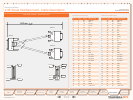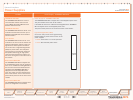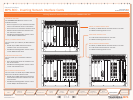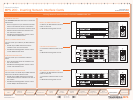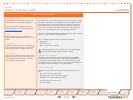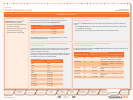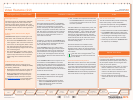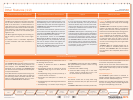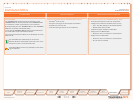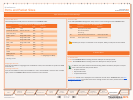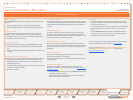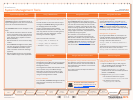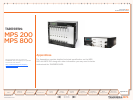
D 13373.08
NOVEMBER 2007
MPS
Table of
Contents
TANDBERG MPS
ADMINISTRATOR GUIDE
Flow Control (Downspeeding
TF
)
IP Adaptive Bandwidth Management
The MCU never produces more traffic than need-
ed, for better utilization of network resources.
Most of the data sent in a videoconference is
video data. Thus, by incorporating smart video
algorithms, the codec sends no more video data
than necessary. Little movement in the picture
gives low bit rate; while a lot of movement gives
higher bit rate.
The MCU regulates outgoing and incoming me-
dia bit rates by means of flow control signal-
ling.
An example of this is automatic adjustment
of total bandwidth used when DuoVideo
TF
is
opened.
Other Features (1:2)
Flow Control (Downspeeding
TF
)
The TANDBERG MPS uses Flow Control to control
the amount of information being received from
each endpoint. If the TANDBERG MPS requires
bandwidth to be changed, the TANDBERG MPS
will use Flow Control to request the other endpoint
to drop the bandwidth.
If the ISDN networks drops channels during a call,
the conference will not shut down but adjust to
the remaining number of available channels. This
ability is called “Downspeeding” and is in accor-
dance to the BONDING Mode 1 standard.
ISDN Downspeeding will be started when one of
the following actions occurs:
Fallback to 2xH221 call when no BONDING 1.
framing is found
Non-matching number of channels (N) during 2.
BONDING setup (e.g. N=4 on site A, N=6 on
site B)
Downspeeding during call setup caused by a 3.
channel that will not connect
Disconnect and downspeed if a channel will 4.
not sync
Downspeeding when detecting B-channels that 5.
are looped
Downspeeding if a channel drops during the 6.
call
The TANDBERG system will also start the BOND-
ING synchronization procedure if there is a long
fatal failure situation:
Extended loss of H221 framing7.
Continuous BCH framing error in the video 8.
stream. If then a channel fails to sync, it will
be disconnected (as mentioned in 4.)
Packet Loss
This feature comes also in handy when using
H.323 over networks with poor QoS such as the
Internet.
If TANDBERG MPS detects excessive packet loss,
it will use Flow Control to downspeed the far end
to overcome the packet loss problem.
Packet loss can occur when routers become over-
loaded and discard packets or when the receiving
video system cannot keep up with the transmit-
ting video system.
Downspeeding on IP
The TANDBERG system follows a multilevel in-
telligent adaptive algorithm based on measured
packet loss when downspeeding on IP.
Different from the ISDN downspeeding, the sys-
tem will not change Audio and Video algorithms
during the downspeeding of an IP call.
IP Adaptive Bandwidth Management Latency and Jitter
Features
Latency & Jitter
Latency is defined as the time between a node
sending a message and receipt of the message
by another node.
TANDBERG MPS can handle any value of latency
however, the higher the latency, the longer the
delay in video and audio. This may lead to con-
ferences with undesirable delays causing partici-
pants to interrupt and speak simultaneously.
Jitter is defined as the difference in latency.
Where constant latency simply produces delays
in audio and video, jitter can have a more ad-
verse effect. Jitter causes packets to arrive out
of order or at the wrong times, which again leads
to packet loss.
TANDBERG MPS can manage packets with jit-
ter up to 200ms. If excessive packet loss is
detected, the TANDBERG MPS will downspeed
the connection until acceptable packet loss is
achieved.
Asymmetrical Encoders and Decoders
Realizing there are many different types of vid-
eoconferencing units in the world that do not
support the same video and audio algorithms,
TANDBERG has implemented asymmetrical en-
coders and decoders.
This feature allows different systems with dif-
ferent video and audio algorithms to communi-
cate with the TANDBERG MPS without having to
settle on the best common protocols.
The asymmetrical nature of the TANDBERG
MPS allows the MCU to accept any of its sup-
ported algorithms in any combination from any
site and will always transmit the highest pos-
sible quality video and audio to the far end.
By this, the TANDBERG MPS can send H.263
and receive H.264 at the same time.
Lip Sync
IP is an asynchronous network that sends au-
dio and video separately. It is easy to see that
these two streams may not arrive at their desti-
nation at the same time. Lip sync problems are
a certainty if precautions are not taken in the
implementation of the codec.
TANDBERG MPS supports sequencing of the
video and audio IP packets and the reassembly
and reordering of these packets at the destina-
tion if they are received out of order. If the vid-
eo stream is received before the audio stream,
the TANDBERG MPS will buffer this data until
the necessary audio is received and reassem-
ble the data that the destination codec will use
to reproduce a clear image with exceptional
sound quality and lip sync.
LipSyncAsymmetrical Encoders and Decoders
159
Introduction
Quick
Setup
Using
the MPS
System
Status
System
Configuration
Installation
Gateway
Configuration
MCU
Configuration
Appendices
Main
Technical
Descriptions




